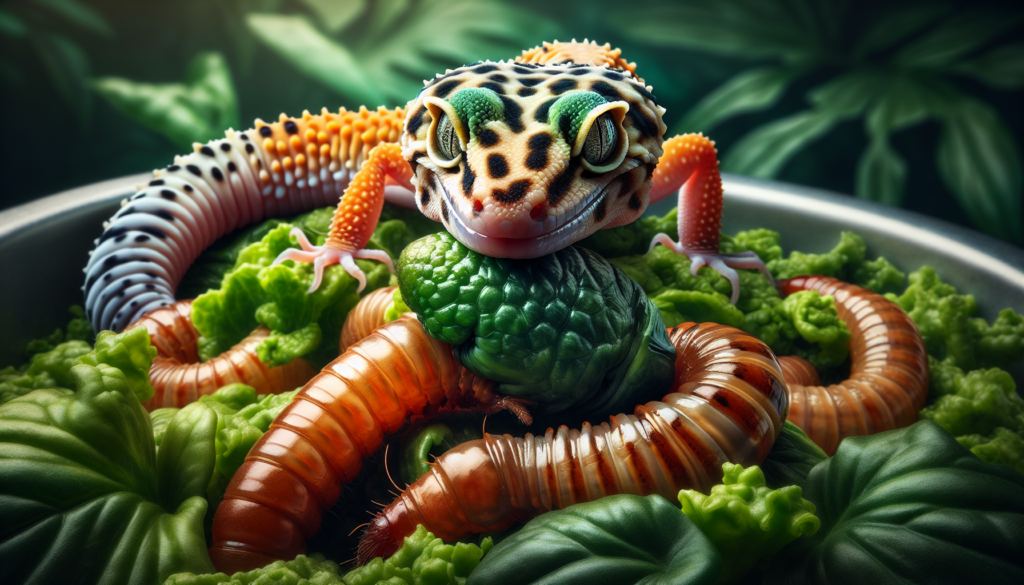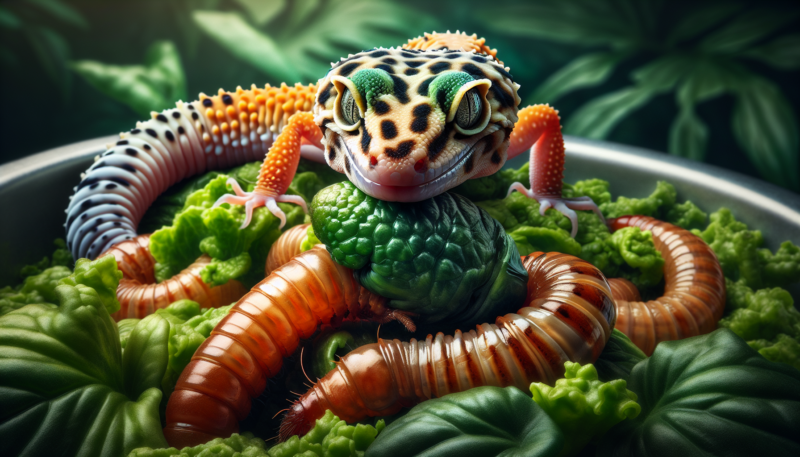Are you curious about the diet of a leopard gecko? Well, you’re in luck! In this article, we will explore the fascinating world of leopard geckos and their dietary needs. From the basics of what they eat to specific nutritional requirements, we’ll cover it all. So, if you’re ready to learn how to keep your leopard gecko happy and healthy through its diet, let’s get started!

Leopard Gecko Diet
Leopard geckos are fascinating reptiles that require a specific diet to maintain their health and well-being. As a responsible owner, understanding their dietary needs is vital. In this article, we will explore the various aspects of a leopard gecko’s diet, including their basic requirements, the importance of live insects as their main food source, gut-loading insects, supplementing with calcium and vitamins, feeding frequency, proper feeding techniques, hydration and water needs, and avoiding non-nutritive substances. Let’s delve into the world of leopard gecko nutrition and ensure your pet thrives!
Understanding Leopard Geckos
Before diving into the specifics of their diet, it’s essential to understand the natural habitat, behavior, and unique digestive system of leopard geckos. These reptiles originate from the rocky deserts of Afghanistan, Pakistan, and parts of northern India. In the wild, they are nocturnal creatures that emerge during the evening to hunt for food. Leopard geckos possess a solitary nature and rely on their well-developed sense of smell to locate prey.
Leopard geckos have a unique digestive system adapted for their carnivorous nature. Unlike herbivorous reptiles, they lack the ability to ferment plant matter. Their short, simple digestive tract is designed for efficient digestion of meat-based diets, making live insects their primary source of nourishment.
Basic Dietary Requirements
For optimal health, leopard geckos require a balanced diet that meets their nutritional needs. A well-rounded diet ensures they receive the necessary vitamins, minerals, and other essential nutrients. It is crucial to replicate their natural diet as closely as possible to support their overall health.
A leopard gecko’s diet should consist primarily of live insects. These insects serve as a rich source of protein, which is essential for their growth, maintenance, and overall wellbeing. In addition to protein, their diet should also include other vital nutrients such as fats, vitamins, and minerals.
Live Insects as Main Food
Live insects are the ideal main food source for leopard geckos. The movement of live prey stimulates their natural hunting instinct and helps maintain their physical and mental well-being. Offering live insects ensures your gecko has an enriched feeding experience.
When selecting live prey, it is important to consider the size of the insects. The prey should be appropriately sized for your leopard gecko’s mouth to prevent choking or ingestion difficulties. Suitable insect species for leopard geckos include crickets, mealworms, superworms, and dubia roaches. These insects provide a well-rounded nutritional profile and are readily available in pet stores or through online suppliers.

Variety of Insects
To cater to your leopard gecko’s natural prey selection, it is crucial to offer a variety of insects. In the wild, their diet would consist of an assortment of insects, which would provide a diverse range of nutrients. Feeding your gecko different types of insects helps ensure they receive a well-rounded diet.
By offering a variety of insects, you provide different flavors and textures, making mealtime more exciting for your gecko. Additionally, diverse prey items contribute to a balanced intake of essential nutrients, potentially reducing the risk of any deficiencies.
Gut-Loading Insects
Gut-loading insects is a practice that involves feeding the insects nutrient-rich foods before offering them to your leopard gecko. This process enhances the nutritional content of the insects and provides a more nutrient-dense meal for your gecko.
Commercial gut-loading products are available and provide a convenient option for enhancing the nutritional value of insects. However, you can also create homemade gut-loading mixes using high-quality fruits, vegetables, grains, and commercial reptile supplements. The duration of gut-loading insects can vary, but a minimum of 24 hours is recommended to ensure adequate nutrient absorption.
Supplementing with Calcium and Vitamins
Leopard geckos require additional supplementation to meet their calcium and vitamin needs fully. Calcium is crucial for their skeletal health, preventing metabolic bone disease. Lack of proper calcium supplementation can lead to skeletal deformities, weakness, and other health issues.
Calcium supplements should ideally be in the form of calcium carbonate or calcium citrate and be finely ground to ensure optimal absorption. These supplements can be dusted onto prey items before feeding. It is important to note that over-supplementation can be harmful, so it is recommended to follow the guidelines provided by a reptile veterinarian or a reputable leopard gecko care resource.
In addition to calcium, leopard geckos may also require vitamin supplementation. Vitamin D3 is essential for calcium absorption, while multivitamin supplements can help fill any gaps in their nutritional needs. Be sure to choose supplements specifically formulated for reptiles and follow the recommended dosage guidelines.
Feeding Frequency
Determining the appropriate feeding schedule for your leopard gecko depends on various factors, including their age, size, and activity level. Younger geckos generally require more frequent feeding, while adults can be fed less frequently.
For hatchlings and juveniles, daily feeding is usually recommended to support their rapid growth and development. As they reach adulthood, feeding every other day or even every three days becomes sufficient. However, it is important to monitor your gecko’s body condition and adjust the feeding schedule accordingly. Maintaining a healthy weight is crucial to prevent obesity or malnourishment.
Proper Feeding Techniques
Creating a suitable feeding area for your leopard gecko is essential to ensure they can easily locate and consume their prey. A shallow dish that is escape-proof and easy to clean is ideal for offering insects. Avoid using dishes with high walls or lids that may hinder your gecko’s access to prey.
Some owners prefer to feed their geckos outside their enclosure to prevent the risk of accidental ingestion of substrate. However, if you choose to feed inside the enclosure, ensure the surface is clean and free from any non-nutritive substances that may pose a health risk.
Hand-feeding can be enticing, but it is worth considering the risks. Leopard geckos have sharp teeth, and accidental biting may occur. To avoid any mishaps, it is best to use feeding tongs or tweezers instead.
Hydration and Water Needs
While leopard geckos primarily obtain moisture from their prey, it is still important to provide a shallow dish of clean, fresh water. Water dishes should be easily accessible and placed in a low-traffic area to avoid contamination. Ensure the dish is cleaned regularly to prevent the buildup of bacteria or other contaminants.
Leopard geckos may not frequently drink from the water dish, but it should always be available as a source of hydration. Additionally, providing a moist hide within their enclosure can offer an extra source of humidity and aid proper shedding.
Avoiding Non-Nutritive Substances
Leopard geckos are prone to ingesting non-nutritive substances, which can lead to serious health complications. It is important to be aware of potential dangers and take precautions to safeguard your gecko.
Certain foods are known to be toxic to leopard geckos, such as onions, garlic, avocados, and chocolate. Additionally, some plants commonly found in households or gardens can be toxic if consumed by geckos. It is essential to research and ensure that their environment is free from any potentially harmful substances.
The choice of substrate within the enclosure is also critical. Avoid using loose substrates, such as sand or wood shavings, as they can cause impaction if ingested. Opt for non-particle substrates, such as reptile carpet or paper towels, to create a safer environment for your gecko.
By following these guidelines and understanding the specific dietary requirements of leopard geckos, you can provide them with a healthy and fulfilling diet. A well-nourished leopard gecko is more likely to thrive, exhibit natural behaviors, and live a long, happy life. Remember, your gecko is relying on you for their nutrition, so make their diet a top priority and enjoy watching them flourish!
